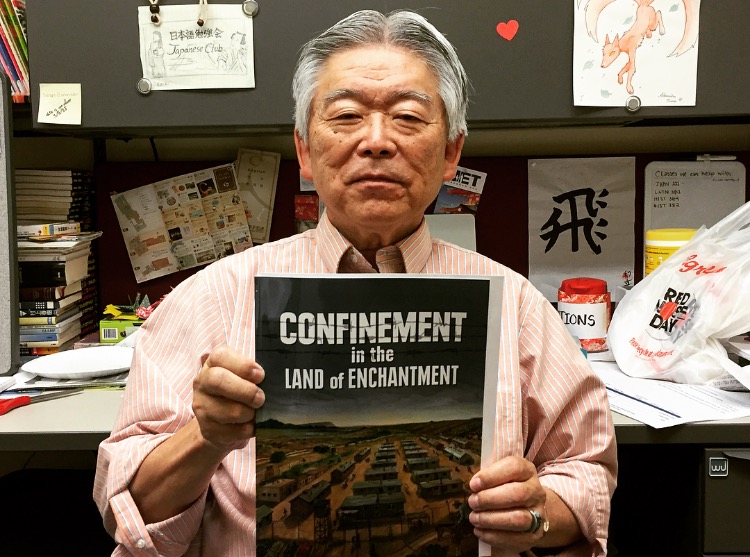In 1942, President Roosevelt signed Executive order 9066 authorizing the removal of all Japanese peoples from the west coast region into internment camps. More than 115 thousand Japanese Americans were rounded up. Six thousand were held in four locations around New Mexico until they were released in 1945.
Victor Yamada, the special project director of the New Mexico Japanese American Citizens League (NMJACL), is hoping to make that chapter of New Mexico history better known.
Yamada said that his group’s Confinement in the Land of Enchantment (CLOE) project is aimed at educating the public that is largely unaware of the Japanese American internments in New Mexico.

“The New Mexico JACL started out initially as a social club for those with Japanese American ancestry,” Yamada said. “But later evolved into a full chapter of the national JACL with the same mission: to protect the civil rights of all Americans but with a focus on Asian Americans, Japanese Americans and to preserve the culture of the Japanese American life.”
Yamada said the CLOE project has three phases. The first phase focused on the collection, research and digestion of historical documents. The second phase focused on the assembly of a well-documented report that they published and sent to every public school and library in the state. The final phase focuses on the creation of an online, interactive map that allows users to get specific information about internment locations around New Mexico.
Yamada also said the NMJACL is working on getting information markers set up along the highways 285 and 599 in Santa Fe directing motorists to the Japanese internment camp memorial monument.
Durwood Ball, an associate professor of history at the University of New Mexico and editor for the New Mexico Historical Review said that following the bombing of Pearl Harbor in 1941, the American people and government feared the possibility that Japan would invade the West Coast. He said the Japanese that lived on the coast were seen as enemies and spies that would potentially group together and undermine the U.S. military’s naval and land operations.
“We saw them as an inferior race, just like the same way we viewed the Chinese and the Filipinos. It was easier for us to justify interning these people because they were inferior and raised inferior to us,” Ball said. “We viewed them as fanatical, bloodthirsty warriors serving their emperor, who would stop at nothing to advance his cause in Asia.”
Ball said that the Japanese people viewed themselves as “loyal American citizens.” He said that many Japanese Americans refused to make an exodus to Japan since they were very much acculturated to America. Overall, he said that they were very much American.
Ball said that many Japanese were gifted farmers and “made more money off less land than most Anglo Americans could” which created a sense of jealousy towards the success of the Japanese farmers. They also had success as businessmen and women and even prospered during the midst of the Great Depression, whereas many anglo men and women did not.
“I think Americans just fell victim to their own hysteria over the Japanese military threat to the Pacific coast and took their grief and fury out on the Japanese Americans,” Ball said. “And made them pay by dispossessing them of everything they had and relocating them too often desolate, backwater areas in the United States.”
The four internment camps in New Mexico were located in Santa Fe, Ft. Stanton, Lordsburg and Baca/Old Raton Ranch. Ball said that because the camps were “hastily erected by the federal government” there were problems such as poor sanitation and running water systems that weren’t complete. The camps were located in desolate areas which made the interned peoples suffer through harsh weather conditions — cold winters, hot summers, high winds — and the camps themselves were overcrowded.
This data was provided by the CLOE project, History.com and the software is powered by IE Insights. Created by Marco Torrez / NM News Port
The national Japanese American Citizens League (JACL) is comprised of more than 10 thousand members in 100 plus chapters across the U.S. The league was founded in 1929 and is the oldest and largest Asian civil rights organization in America. The New Mexico JACL chapter originated in 1947 and is a part of the JACL Pacific Southwest District (PSW), which includes New Mexico, Nevada, Arizona and the Southern California area.
The NMJACL is also in charge of running various local events throughout the year in Albuquerque. One is Albuquerque’s annual Akimatsuri (Japanese Fall festival), which drew an estimated 3 thousand people this past September. The most recent event was the 2018 Matsuri Games, a USKA Regional Mountain States Martial Arts Championship held in February at the Legacy Church Gym in Albuquerque.
You can follow Marco Torrez on Twitter @marcopolo7721